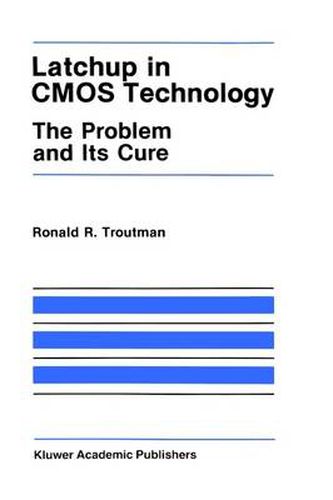Readings Newsletter
Become a Readings Member to make your shopping experience even easier.
Sign in or sign up for free!
You’re not far away from qualifying for FREE standard shipping within Australia
You’ve qualified for FREE standard shipping within Australia
The cart is loading…






This title is printed to order. This book may have been self-published. If so, we cannot guarantee the quality of the content. In the main most books will have gone through the editing process however some may not. We therefore suggest that you be aware of this before ordering this book. If in doubt check either the author or publisher’s details as we are unable to accept any returns unless they are faulty. Please contact us if you have any questions.
Why a book on Iatchup? Latchup has been, and continues to be, a potentially serious CMOS reliability concern. This concern is becoming more widespread with the ascendency of CMOS as the dominant VLSI technology, particularly as parasitic bipolar characteristics continue to improve at ever smaller dimensions on silicon wafers with ever lower defect densities. Although many successful parts have been marketed, latchup solutions have often been ad hoc. Although latchup avoidance techniques have been previously itemized, there has been little quantitative evaluation of prior latchup fixes. What is needed is a more general, more systematic treatment of the latchup problem. Because of the wide variety of CMOS technologies and the long term interest in latchup, some overall guiding principles are needed. Appreciating the variety of possible triggering mechanisms is key to a real understanding of latchup. This work reviews the origin of each and its effect on the parasitic structure. Each triggering mechanism is classified according to a new taxonomy.
$9.00 standard shipping within Australia
FREE standard shipping within Australia for orders over $100.00
Express & International shipping calculated at checkout
This title is printed to order. This book may have been self-published. If so, we cannot guarantee the quality of the content. In the main most books will have gone through the editing process however some may not. We therefore suggest that you be aware of this before ordering this book. If in doubt check either the author or publisher’s details as we are unable to accept any returns unless they are faulty. Please contact us if you have any questions.
Why a book on Iatchup? Latchup has been, and continues to be, a potentially serious CMOS reliability concern. This concern is becoming more widespread with the ascendency of CMOS as the dominant VLSI technology, particularly as parasitic bipolar characteristics continue to improve at ever smaller dimensions on silicon wafers with ever lower defect densities. Although many successful parts have been marketed, latchup solutions have often been ad hoc. Although latchup avoidance techniques have been previously itemized, there has been little quantitative evaluation of prior latchup fixes. What is needed is a more general, more systematic treatment of the latchup problem. Because of the wide variety of CMOS technologies and the long term interest in latchup, some overall guiding principles are needed. Appreciating the variety of possible triggering mechanisms is key to a real understanding of latchup. This work reviews the origin of each and its effect on the parasitic structure. Each triggering mechanism is classified according to a new taxonomy.